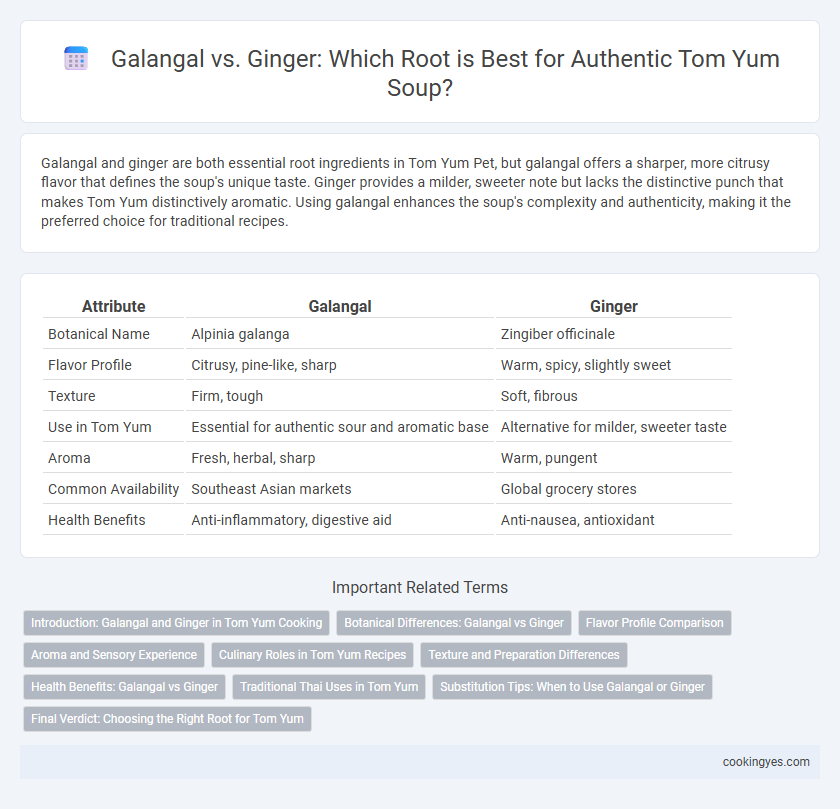Galangal and ginger are both essential root ingredients in Tom Yum Pet, but galangal offers a sharper, more citrusy flavor that defines the soup's unique taste. Ginger provides a milder, sweeter note but lacks the distinctive punch that makes Tom Yum distinctively aromatic. Using galangal enhances the soup's complexity and authenticity, making it the preferred choice for traditional recipes.
Table of Comparison
| Attribute | Galangal | Ginger |
|---|---|---|
| Botanical Name | Alpinia galanga | Zingiber officinale |
| Flavor Profile | Citrusy, pine-like, sharp | Warm, spicy, slightly sweet |
| Texture | Firm, tough | Soft, fibrous |
| Use in Tom Yum | Essential for authentic sour and aromatic base | Alternative for milder, sweeter taste |
| Aroma | Fresh, herbal, sharp | Warm, pungent |
| Common Availability | Southeast Asian markets | Global grocery stores |
| Health Benefits | Anti-inflammatory, digestive aid | Anti-nausea, antioxidant |
Introduction: Galangal and Ginger in Tom Yum Cooking
Galangal and ginger are key root ingredients that define the distinct flavor profile of Tom Yum soup, with galangal offering a sharp, citrusy, and slightly pine-like aroma, while ginger provides a milder, warm, and peppery taste. In traditional Tom Yum recipes, galangal is preferred for its ability to enhance the soup's bright, spicy, and herbal notes, contributing to its signature aromatic complexity. The choice between galangal and ginger influences the dish's authenticity and depth, with galangal being more emblematic of classic Thai cuisine.
Botanical Differences: Galangal vs Ginger
Galangal (Alpinia galanga) and ginger (Zingiber officinale) differ botanically, with galangal featuring a tougher, pale tan skin and white to pinkish flesh, while ginger has a thinner, brownish skin and yellow interior. Galangal's rhizome has a more fibrous texture and a sharper, citrusy, pine-like flavor profile, contrasting with ginger's softer texture and warm, spicy, slightly sweet taste. Both roots belong to the Zingiberaceae family but vary significantly in chemical composition and culinary use in dishes like Tom yum.
Flavor Profile Comparison
Galangal imparts a sharp, citrusy, and pine-like flavor with a hint of earthiness, creating a distinct aromatic intensity unique to Tom yum soup, while ginger offers a milder, sweet-spicy warmth with peppery undertones. The use of galangal enhances the traditional Southeast Asian authenticity and complexity, whereas ginger provides a subtler, more familiar zest to the broth. This flavor profile comparison highlights galangal as the preferred root for an authentic, bold Tom yum, contrasting with ginger's gentler, more accessible taste.
Aroma and Sensory Experience
Galangal imparts a sharp, citrusy aroma with a slightly pine-like undertone, creating a complex sensory profile essential to authentic Tom Yum. Ginger offers a warmer, spicier scent with a subtle sweetness, resulting in a milder but still invigorating flavor. The choice between galangal and ginger dramatically influences the dish's aromatic depth and overall sensory experience, with galangal providing a more distinctive and traditional essence.
Culinary Roles in Tom Yum Recipes
Galangal and ginger serve distinct culinary roles in Tom Yum recipes, with galangal providing a sharp, citrusy, and slightly piney flavor essential for authentic Thai taste, while ginger offers a milder, sweeter, and warming profile. Galangal's fibrous texture and robust aroma enhance the broth's complexity, making it the preferred root in traditional Tom Yum preparations. Using ginger instead results in a subtler flavor, often altering the characteristic zesty balance that defines classic Tom Yum soup.
Texture and Preparation Differences
Galangal root offers a firm, fibrous texture that requires thin slicing or pounding to release its aromatic oils, providing a more citrusy and earthy flavor to Tom yum. In contrast, ginger has a softer, less dense texture that is easier to grate or slice finely, imparting a warmer, spicier note to the broth. Preparation methods for galangal often involve removing the tough outer skin and using larger chunks to prevent overpowering the dish, while ginger's thin slices or julienne cuts dissolve more readily, blending smoothly into the overall flavor profile.
Health Benefits: Galangal vs Ginger
Galangal and ginger both offer powerful health benefits in Tom Yum, with galangal known for its strong anti-inflammatory and antimicrobial properties that aid digestion and boost immune function. Ginger is rich in antioxidants and has been extensively studied for its ability to reduce nausea, improve circulation, and ease muscle pain. While both roots support digestive health, galangal's unique compounds target bacterial infections more effectively, making it a potent addition to traditional herbal remedies.
Traditional Thai Uses in Tom Yum
Galangal is the preferred root ingredient in traditional Thai Tom Yum, prized for its sharp citrusy and pine-like aroma which defines the soup's authentic flavor profile. Unlike ginger, which has a sweeter and more peppery taste, galangal contributes a unique earthy bitterness crucial to balancing the spicy, sour, and savory elements of Tom Yum. Its fibrous texture and potent essential oils make it a staple in classic Thai recipes, ensuring the dish's signature complexity and medicinal benefits.
Substitution Tips: When to Use Galangal or Ginger
Galangal offers a sharp, citrusy, and slightly piney flavor that defines authentic Tom yum, making it essential for traditional recipes seeking a bold, aromatic profile. Ginger provides a milder, sweeter, and warmer taste, suitable as a substitute when galangal is unavailable, especially to soften the soup's intensity without compromising warmth. Use galangal for a vibrant, tangy complexity, and ginger for a gentler, more accessible alternative that complements other bold Tom yum spices.
Final Verdict: Choosing the Right Root for Tom Yum
Galangal provides a sharp, citrusy aroma and a slightly peppery flavor essential for authentic Tom Yum, contrasting with ginger's sweeter and earthier taste. The distinct pine-like notes of galangal elevate the soup's complexity, while ginger offers a milder, less vibrant flavor profile. For a true traditional Tom Yum experience, galangal is the preferred root ingredient, delivering the signature taste that defines this iconic Thai dish.
Galangal vs Ginger for root ingredient Infographic

 cookingyes.com
cookingyes.com